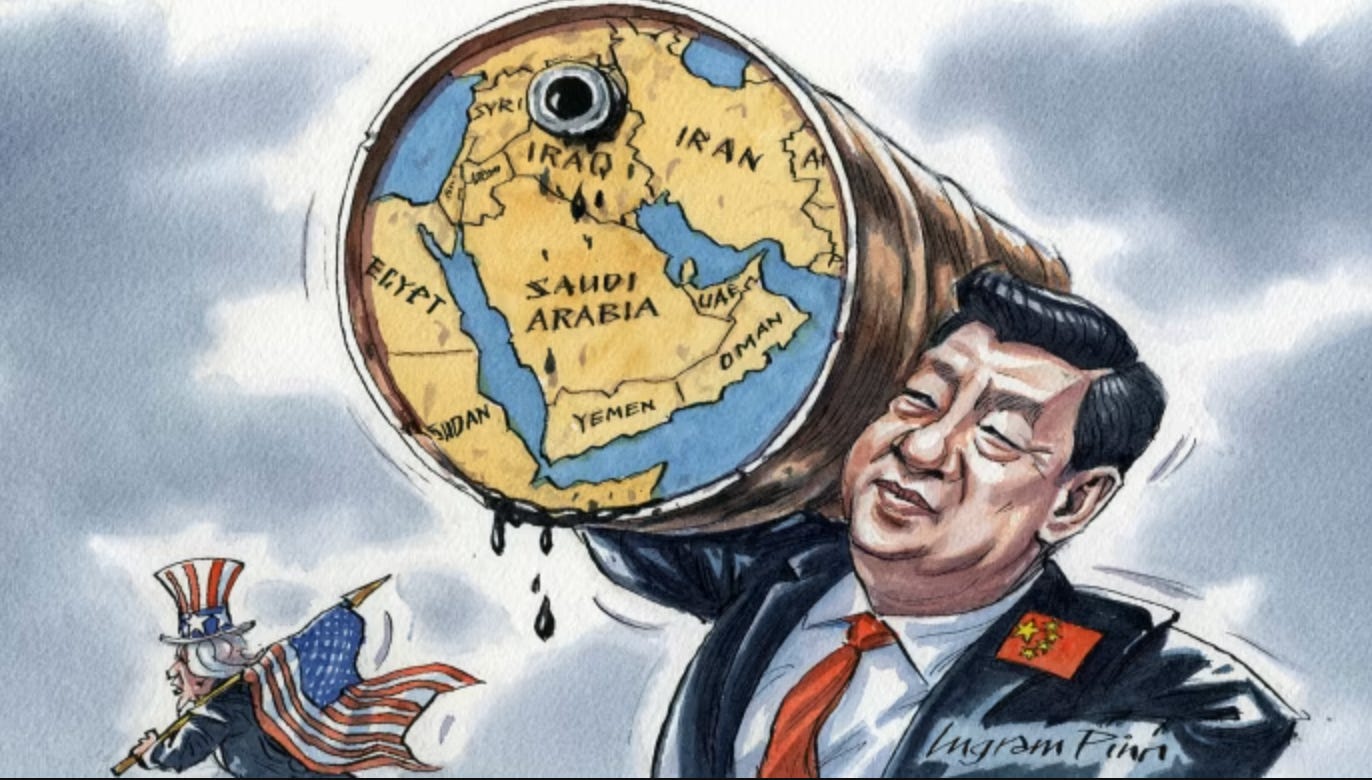Hello and welcome back to What China Wants. As you might have seen me post, the other day I contributed to a piece in the Nikkei on China’s engagement with Syria and what it means for its overall Middle East policy.
Today I thought I would expand on this to look at what China really wants from the Middle East, and how Syria falls into that.
The overriding reason for China’s interest in the Middle East is energy security, an important issue for the world’s leading energy importer. Much of China’s gas, and about half of its oil comes from the region.
Beijing also takes an interest there because it is concerned about Islamic ideologies spreading that could rear their head in Western China, specifically Xinjiang. There are plenty of commercial and technological opportunities too, with much of the digital infrastructure there having been built by Chinese firms like Huawei.

China has built political relationships with US allies and foes in the region alike, all the while building out a strong commercial relationship. As the US fought in Iraq and elsewhere, so China quietly built up its presence. As an Indian minister said a few years ago, “For the last 20 years, the United States has been fighting but not winning in the Middle East, and China has been winning but not fighting in the Middle East.”
China is viewed as a welcome player by many governments. Iran, of course, is one of them, given that it is under sanctions by the West. In 2020 it struck a $400 billion oil-for-investment deal that promised much for the embattled regime, although it is unclear how much China has kept its side of the bargain and made any investments.
Countries traditionally in the US orbit are more and more aligned with China, none more so than the UAE. The country has joined the Beijing-dominated BRICS group, and has gone one stage further and conducted regular military exercises with China (including air force trials over the skies of Xinjiang, which is somewhat ironic when the fate of the Muslim Uighurs is considered). Saudi Arabia, on the other hand, refused to accept its BRICS membership earlier this year and is still hedging its bets between the Great Powers.
Syria was closer to Russia, with Moscow playing a key role in the propping up of the Assad regime. That didn’t stop China and Syria supporting each other in the UN. Between 2011 (the start of the Syrian civil war), eight of the nine vetoes used by China in the Security Council involved Syria; for Russia, it was fourteen out of nineteen. With this multilateral support in mind, Beijing was fine talking to the Assad regime, even if there wasn’t much of an economic relationship. The China-Syria relationship reached a peak in 2023 with Assad’s visit to Beijing, and the announcement of a strategic partnership.
But China is now on the losing side there. This doesn’t though mean its relationship with the new Hayat Tahrir al-Sham (HTS) leadership is dead in the water. HTS has long been proscribed as a terror group by the West – although governments are scrambling to undo this – and so it is not as if HTS’s leader, Mohammed al-Jolani, has an obvious new international partnership bloc to join. China also has a trump card in “easy money” for the massive reconstruction the country needs – even in 2021 the rebuild cost was estimated at $250 billion. It is therefore not in China’s interest to dwell on its relationship with Assad and avoid engaging with an HTS-led Syria.
Russia certainly wants there to be a good relationship between the two. Putin invested heavily in Assad, and killed a lot of people on his behalf, probably in the tens of thousands. (By the end of 2018 alone Russian forces had killed 7,700 civilians, according to The Syrian Observatory for Human Rights.) In return Moscow received access to the Tartous naval base, giving it the ability to project power in the Mediterranean and reinforcing Putin’s desire to make his country a world power again.
The Russian fleet has temporarily evacuated Tartous, waiting to know what will befall the base under HTS. If Moscow can keep hold of it after all Russian forces have done then this will be a geopolitical win for Putin. Given the strong relationship between China and Russia, it would be strange indeed if the fate of Tartous did not come up in future conversations between Beijing and Damascus. Massive Chinese investment into the country while keeping a Russian naval presence could be on the cards, especially if the Chinese were able to use Tartous too.
The wider question for the region is the future level of Chinese influence there. If it does invest in Syria – if it is allowed to invest in Syria – then this will be in keeping with the recent years of rising involvement.
This comes at a time when many in the US are questioning whether America should be in the region these days, especially now that the country is effectively energy independent. Oil and gas are not, however, the only reason to be in the region. Apart from its geographic proximity to core allies in Europe and the role it plays in the connectivity with Asia (especially the Suez Canal), there is also the lingering threat of Iran and its nuclear weapons. It is for these reasons, as well as continued support for Israel, that we are unlikely to see a full pull out under Trump 2.0.
In sum, the fall of Assad is not likely to change the overall theme of Great Power rivalry in the Middle East. China will still be there, as will the US. Countries in the region have already shown how they are able to manage both sides, and they will be doing so for many years to come.



